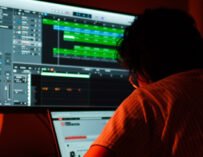
The sounds in EZKeys Grand Piano have been sampled from a genuine Steinway
Perhaps best known for its EZDrummer beat-making packages, Toontrack introduces a brace of virtual pianos with handy songwriting tools built-in
![]() irtual instrument plug-ins such as these are often considered the preserve of dance and hiphop producers, with ‘real’ songwriters using ‘real’ instruments. But is that really true any more? Modern songwriting can take many different shapes and forms, and while many Songwriting readers may indeed be accomplished pianists, many others may not. Perhaps you’re a pop songwriter who’s more comfortable working ‘in the box’; perhaps you’re a guitarist but want to be able to present musical ideas to your bandmates and co-writers in a more rounded fashion; perhaps you are a pianist, but fitting the old Joanna on a tour bus or aeroplane has been proving tricky.
irtual instrument plug-ins such as these are often considered the preserve of dance and hiphop producers, with ‘real’ songwriters using ‘real’ instruments. But is that really true any more? Modern songwriting can take many different shapes and forms, and while many Songwriting readers may indeed be accomplished pianists, many others may not. Perhaps you’re a pop songwriter who’s more comfortable working ‘in the box’; perhaps you’re a guitarist but want to be able to present musical ideas to your bandmates and co-writers in a more rounded fashion; perhaps you are a pianist, but fitting the old Joanna on a tour bus or aeroplane has been proving tricky.
In other words, there are many situations in which virtual instruments can be a useful weapon in the songwriter’s arsenal. Enter these two new VST pianos from Toontrack, which claim “instrument, performer and co-writer” status. We wanted to see if they could live up to the hype, so once we’d downloaded, installed and authorised the software via the Toontrack website – a process that was remarkably painless – it was time to put them under the Songwriting reviews oscilloscope…
“This instrument could happily take centre-stage”
EZKeys Grand Piano samples a Steinway with great detail and clarity. This visually beautiful piano set gives you 13 pre-set ‘signal chains’, from the classic sounds you would expect to a full-blown supernatural, sci-fi influenced piano. Each of these pre-sets is customisable, and most of them would be very usable in commercial projects. The sonic depth, realistic sound and attention to detail mean that this instrument could happily take centre-stage in a vast array of different applications.
EZKeys Upright Piano, meanwhile, is sampled from an Östlind & Almquist piano with the same precision and care that we’ve come to expect from any Toontrack instrument. The sound of this piano would be better suited to playing a backing role in a blues, folk or jazz outfit: it has a useable sound but it’s more of a workhorse that can drive melodic rhythms than it is an instrument to put upfront. Sonically, it puts me in mind of old, cracked red leather chairs in smoky jazz cafés: cool, hipster-friendly and stylish, but not necessarily to everyone’s taste.

EZKeys Upright Piano’s sounds are sampled from an Östlind & Almquist
One factor that determines the quality of VSTs is the ability to capture the dynamics of the original, analogue instrument. When testing EZKeys, both instruments had a good dynamic range, slightly leaning towards the louder end in the detail. For most pop applications, the range between pianissimo and fortissimo will more than cover your needs, and allow you to convey a good sense of texture and emotive content in the piano parts.
Instant access
As a songwriter, you never know when inspiration might strike. Now, when it does, instead of waiting what feels like an eternity for your favourite DAW to load you can have EZKeys loaded and recording in less than 30 seconds, because it can function as a standalone instrument as well as a DAW plug-in.
This is where EZKeys really starts to come to life. The more inspiring features in standalone mode include a MIDI browser, chord generator and simplified arrangement tool to help quickly capture your ideas with inspiring sonic results. The arrangement window does lack the detail and editing features of even the simplest modern day DAWs, but with EZKeys you feel like this isn’t really the point. The idea with these tools is to paint broad-brush strokes marking out verses, chorus and bridge sections with ease.
For days when you are lacking inspiration, there are also many functions such as customisable MIDI files and random chord generators that can help to get the ball rolling. Finally, EZKeys also comes with some basic music theory tuition – so if the ‘circle of fifths’ approach in the arrangement section intimidates you, it shouldn’t do after reading a few pages of the PDF guide.

The MIDI browser
To look slightly more closely at the practical features, the software works with a single sustain pedal, or with three pedals if desired. This will add to any MIDI performance and having soft, sostenuto and sustain is definitely a bonus. When loading it up in standalone mode for the first time the software needed a prompt in the settings menu to find the MIDI keyboard and soundcard. When using the standalone version it runs automatically in 64-bit to give the highest quality results. This will be fine if your computer is fast and current, but if you are near the minimum spec, you may run into a few minor issues.
Used inside a sequencer, EZ Keys works perfectly as a classic instrument. The only time this becomes an issue is if you try to use your DAW and EZKeys arrangement windows at the same time – then you may run into synchronisation issues with your other instruments.
Both of these instruments are priced at €139 (£110 or $185 approx), which is certainly competitive. Other similar products include Native Instruments’ Alicia Keys and The Giant, both pianos individually priced at £89 and boasting a solid sound at a cheaper price. There is also the stunning Ivory 2 piano to consider: this is arguably the industry standard for virtual piano, but at £199 it is not cheap. While both of these similar products are very good, though, EZKeys’ simple but powerful songwriting tools are something to be revered.
Verdict: Two deceptively powerful workhorses that would make a great songwriter’s companion
![]()
![]()
![]()
![]()
![]() (EZKeys Grand)
(EZKeys Grand)
![]()
![]()
![]()
![]()
![]() (EZKeys Upright)
(EZKeys Upright)
Matt Chapman
[cc_full_width_col background_color=”f1f1f1″ shadow_color=”cccccc” radius=”6″]Specifications/system requirements
- PC: Windows XP SP3 or higher, Pentium IV/Athlon 1.8GHz
- Mac: OS X 10.5 or higher, G5 or Intel processor
- 1GB RAM
- 32- and 64-bit support
- Standalone, AU, AXX, RTAS and VST modes
- Licence: Covers two computers
- Install size: 650MB approx
Price
€139 (£110/$185)
Website
www.timespace.com/toontrack
[/cc_full_width_col]


































Related Articles